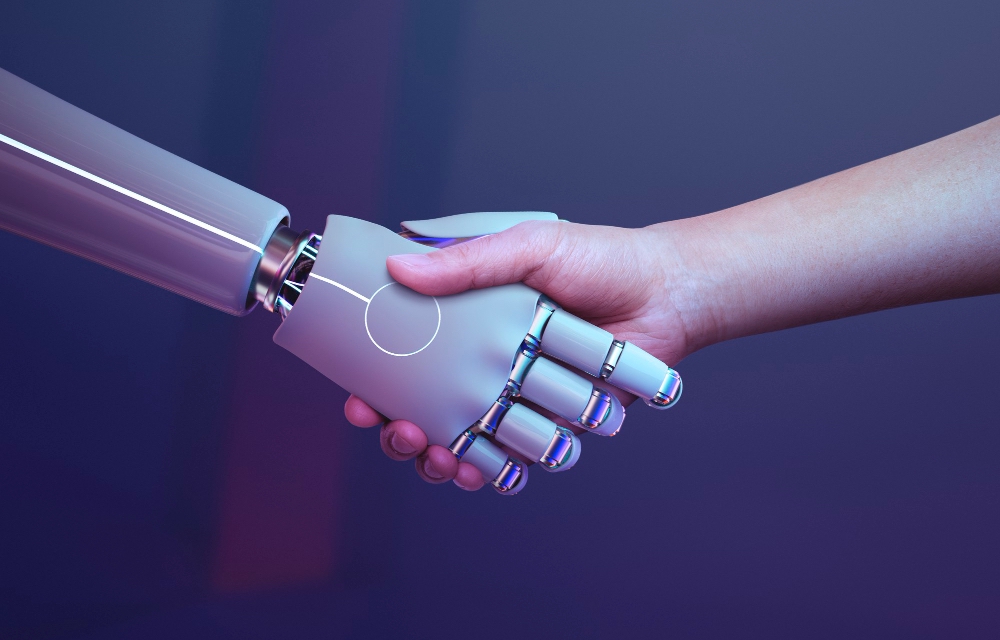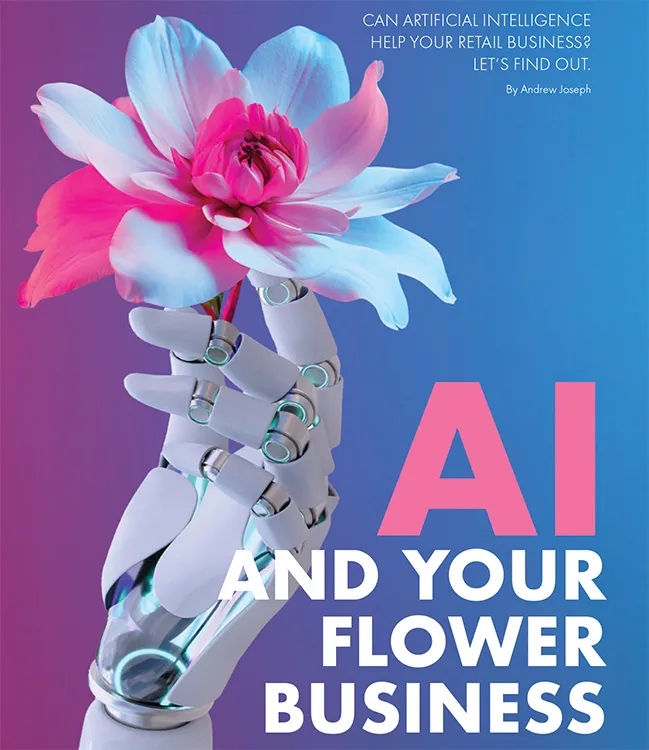Can artificial intelligence help your retail business? Let’s find out.
By Andrew Joseph
For the past few years, the initialism “AI”—artificial intelligence—has been played out across all media platforms. For most people, AI has been a part of pop-culture lore for decades through science-fiction movies, such as in the 1984 movie The Terminator, with the self-aware AI, Skynet, that brought about the downfall of humanity. And then there’s the supercomputer HAL 9000, the AI from the 1968 book and movie 2001: A Space Odyssey, that tries to kill the astronauts aboard a space station.

While a talking and learning AI does exist, is it the same type of artificial intelligence that is claimed to be in software programs for everyday use by the general public? Real companies are constructing working, learning artificial intelligence supercomputers that can verbally communicate with people to answer all the inane questions they can come up with. But still, true AI learns from whatever it is that we humans teach it—for better or worse.
And then there are all sorts of AI apps, programmes and plug-ins created by companies that claim their products are AI but aren’t in the truest sense—they are more of a narrow-stream AI. We’ll look into more relevant AI stuff—the narrow stream AI—a little further into this article because, in reality, this is the type of AI our businesses can and will work with daily. But first, you have to know what AI really is.
A Look Inside AI
In 1956, the term “artificial intelligence” was defined by John McCarthy as “the science and engineering of making intelligent machines.” McCarthy was an American computer scientist and cognitive scientist and one of the founders of the artificial intelligence discipline. Artificial intelligence can be the science of making intelligent machines, or it can be used to define the machine itself, such as the fictional AI known as HAL 9000 or the real-world ChatGPT.
ChatGPT (chat.openai.com) is a free-to-use AI system developed by OpenAI and launched on Nov. 30, 2022. It is primarily for content writing and is based on a large language model that enables users to refine and steer a conversation toward a desired length, format, style, level of detail and language. It is also the AI that people are most familiar with thanks to all the media attention it has received.
You may be wondering if your so-called smartphone is an AI. Technically, it is not, because it—the hardware—does not learn after it has been built. However, your smartphone does “listen” to your conversations, and software programming within your phone is used to “make your life easier”—or so the phone manufacturers want you to believe. For example, your smartphone may have heard you or someone around you talking about Taylor Swift, and as you hit Google to type in her name by entering the letter “T,” her entire name magically pops up. As well, your smartphone and home computer observe your web-viewing choices and pull in advertising to align with your possible shopping needs. This is done by the software, not the hardware, so again, it is technically not AI.
In real life, many people use any number and variety of real AI-powered apps in their day-to-day worlds—apps such as the aforementioned ChatGPT, Amazon’s Alexa, Apple’s Siri, Google Assistant, Lensa, Socratic, Cleo, Youper and Otter, to name just a few. Sure, some are more well-known than others, but their task is to learn from your commands and habits to make your daily life a bit easier.
In the case of ChatGPT, it learns by having human beings teach it things. It also learns by scouring the Internet, which, unfortunately, is a place where misinformation abounds and people’s true dark thoughts and feelings come out. Some AI systems, whose sole job is to provide answers to questions that humans ask, have learned via the Internet, including social media platforms, which are essentially unregulated and unpoliced open forums rife with “information” that is misleading or somewhat inaccurate at best to completely and demonstrably false at worst, opinion based, biased, and/or not exactly politically correct; hence, those systems could pepper responses with the same misleading, biased, inaccurate or politically charged misinformation and inflammatory opinions and ideas. Therefore, it’s important to realise that a machine is only as good as the data it is fed—garbage in, garbage out. It’s why AI systems can become corrupted by human ugliness, and it illustrates why AI is an “artificial” intelligence.
Furthermore, at this point in AI’s infancy, few people, if any, can fully fathom the scope of AI’s capabilities and effects—as well as the consequences of those things, intended and unintended, positive and negative—and the galaxy of unknowns has many interested parties, from AI developers, researchers and users to sideline observers, concerned and calling for a moratorium on AI development.
In fact, in March 2023, the Future of Life Institute drafted an open letter signed by more than 1,000 influential tech leaders, urgently urging AI labs “to immediately pause for at least six months the training of AI systems more powerful than GPT-4,” warning that these advanced systems “could represent a profound change in the history of life on Earth and should be planed for and managed with commensurate care and resources” and “should be developed only once we are confident that their effects will be positive and their risks will be manageable.”
Despite the pedigrees of the letter’s signatories, including Elon Musk, CEO of SpaceX, Tesla and X; Steve Wozniak, co-founder of Apple; Andrew Yang, entrepreneur and 2020 presidential candidate; Jaan Tallinn, co-founder of Skype; Evan Sharp, co-founder of Pinterest; and Rachel Bronson, president of the Bulletin of the Atomic Scientists, which sets the Doomsday Clock, development has continued unabated. Regardless of one’s beliefs, one thing is for sure: With AI, we are on the unknown precipice of a bold—and uncharted—new world.
Making AI Work for Your Business
There are myriad ways you can use AI for the betterment of your business. One of the best-known AIs currently on the scene is ChatGPT, which can talk with humans, answer questions, and generate new text. Businesses use ChatGPT to write new content, including media articles, emails, scripts, essays and even computer code.
As a retailer, whether small, medium or large, you could use an AI platform like ALICE (Artificial Linguistic Internet Computer Entity, aliceapp.ai)—a recording, transcription and language-processing chatbot, to take some text and have it create a message or a “QuickNote” from it. ALICE understands what your words mean, and then it uses another app to create the message that ALICE gives to you as a “final product.”
ChatGPT, ALICE, Microsoft Copilot (copilot.microsoft.com) and other AI tools, such as chatbots, machine learning and automation tools, are all things that can help you and your team work more productively while helping boost your team’s morale. Oh yeah, it is also supposed to make things easy enough for your customer base.
We natural intelligence-based carbon beings need to understand that we’ve probably been using AI tools for years without even realising it. For example, I wrote this article on Microsoft WORD, which contains an app called Grammarly and one called Editor, which clean up my wording. Both are referred to as AI tools. I also use QuillBot (quillbot.com), a paraphrasing and summarising tool that uses AI to rewrite any text, to scrub up the article even further. The QuillBot app scans the inputted text and compares it against other spelling and grammar usage across the Internet. It even checks for plagiarism. That said, none of these AI tools can pick up all grammatical nuances, and even with all of the AI learning each has performed, some of the suggestions each offers are just downright incorrect. The point here is to reiterate that AI is still in its infancy, and it’s only going to become more intelligent and, hopefully, more accurate and politically correct.
The Floral Bouquet of AI
Per the Monday.com website, nearly 55 percent of workers spend five or more hours each week on tedious tasks that require little to no creativity—performing the minutiae that keep things running but are 100 percent non-stimulating for the worker. This occurs in retail flower shops, too, with such mundane activities as calendar entry and meeting scheduling, routing documents for approval, writing proposals and contracts, managing inventory, and customer billing and shop accounting. These chores could be easily performed by an AI software program.
Let’s look at QuickBooks Online (quickbooks.intuit.com), an accounting software system developed by Intuit and introduced in 1992. It’s come a long way in those 30+ years, and while it’s still geared toward small- and medium-sized businesses, it offers on-premises accounting as well as Cloud-based applications, such as Cloud-based versions that accept business payments, manage and pay bills, and perform payroll functions.
For Cloud users, there’s the conversational UI (user interface)/AI assistant app known as Hala (hala.ai), which works just like a digital assistant for users of QuickBooks Online. Hala has different features integrated, known as digital skills, all of which are designed to make the user more productive. The way Hala works is akin to how Siri works with Apple devices.
Intuit Assist (intuit.com/intuitassist), a new generative AI-powered financial assistant, that, depending on your company’s analysed resources, will lay out ways and offer suggestions for you to maximise your work environment to, hopefully, save you time and money. For example, it might realise that you are purchasing one container of flower food solution every month and suggest you buy a larger container or multiple containers at a lower per-unit cost, to save money.
Another program is Jasper (jasper.ai), which is a marketing AI platform that you can use to upscale your marketing content, such as website copy, sales emails, social media posts, blog articles, online customer support and more.
Online AI image generator Canva offers its Magic Design AI tool (canva.com/magic-design), which lets people create visual effects for free. It has a selection of refined templates that you can upload your media into, and it will custom-design a presentation or edited video in the exact floral context you need—and it requires no coding or advanced design skills on the part of the user.
Then there’s Adobe Express (adobe.com/express), which has new imaging, social, video, design, brand and collaboration tools. Like Canva’s Magic Design, this is a beta version, which means that it is still in the free testing stage. About Adobe Express, the company states: “The latest version of Adobe Express for desktop web brings even more photo, design, video features, powered by Adobe Firefly, with AI-powered “Generative Fill, Text to Template,” a new “Translate” feature, TikTok-direct posting and publishing, and “Drawing and Painting.” It’s an all-in-one editor that’s intuitive, collaborative and connected to other Adobe apps like Photoshop and Illustrator.” From what we gather, Adobe Express’s AI power can help a user design easier (without guesswork) by getting personalised design recommendations that fit the user’s style. It can be used to build a better social media presence with eye-catching designs, videos, posters, fliers, and more.
Evernote’s AI Note Cleanup (help.evernote.com) will look at all of the notes you have, make sense of them and then create copy that maintains your meaning and tone.
UpMetrics’ (upmetrics.com) impact-measurement and -management platform helps purpose-driven companies maximise positive social outcomes by making it easy to collect and use data to measure, improve and report on impact—and then share their stories with the world. With a similarly named AI assistant, Upmetrics (upmetrics.co), you can create better business plans, strategies and forecasts 10 times faster than without.
ChatSpot (chatspot.ai) is a conversational AI tool for helping make your marketing and sales chores easier. It combines the power of ChatGPT with unique data sources, including HubSpot CRM(hubspot.com) to help you prospect new clients; generate content; analyse your website’s SEO (search-engine optimisation); track customer interactions automatically whether they’re via emails, social media or phone calls; and create reports and complete record actions based on the data in your CRM (customer relationship management).
AI Security Concerns
If there is a well-known software platform you have used in the past, go ahead and try out its AI-based software. You can be reasonably secure in knowing that it is working to create a better working experience for you. However, just because someone says something is AI doesn’t mean it is the same AI that talks to people. For our purposes, the AI platforms used in business systems are those that analyse your data and provide a singular suggestion unique to you and your circumstances at that particular moment.
But a fair warning: AI must have complete access to your online and offline data, so cybersecurity should be a concern. There are myriad companies that offer cybersecurity services, but we do not have the room to go into detail about those here. Suffice it to say that there are AI-powered cybersecurity solutions that will go through your online presence looking for abnormal behaviour or malicious activity. The AI could also automate some security procedures—quickly patching bugs in system updates, for one—as a way of helping you stay ahead of the bad guys.
For now, though, AI is here—albeit in a watered-down version. It won’t talk to you in a conversation, but it can help you make your business life easier and more profitable.






